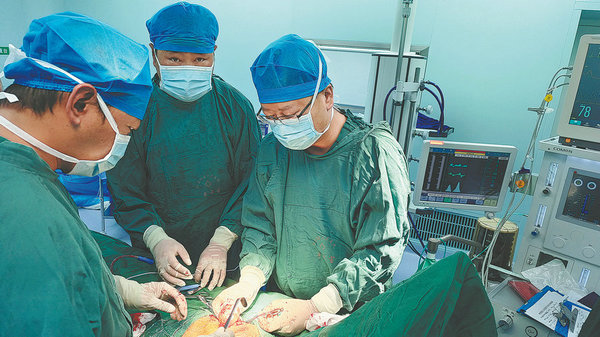

Teams of doctors from Shaanxi province are providing critical treatment to the people living in some of Tibet's most remote areas and elevating the quality of service available at 4,500 meters above sea level, Li Yingxue reports.
On Nov 17, 2021, in the world's highest altitude catheterization lab in Ngari prefecture, Tibet autonomous region, Luo Yongbai, alongside his colleagues, successfully executed an interventional angiography for a patient with critical coronary heart disease.
It was the 13th coronary angiography carried out since the chest-pain treatment center in Ngari Prefecture People's Hospital opened last September.
Luo, 39, a doctor from the department of cardiology at the First Affiliated Hospital of Xi'an Jiaotong University in Shaanxi province, is a member of the seventh batch of Shaanxi's medical aid team for Tibet.
Last August, the team of 42 doctors, drawn from different hospitals in Shaanxi, arrived in Ngari prefecture, nicknamed "the roof on the roof of the world", and began their yearlong secondment working at local hospitals.
As soon as Luo arrived, he started planning the establishment of the treatment center. Acute chest pain is a common symptom in emergency departments, and one which needs quick and accurate diagnosis, especially in the case of a heart attack, Luo says, and if the patient is not effectively treated inside the "golden hour", it will be life-threatening.
"It takes 20 hours by car to transfer a patient to the hospital in Lhasa; for some critically ill patients, there is simply not enough time," Luo adds.
Because there used to be no cardiovascular specialists at the Ngari Prefecture People's Hospital, the treatment process for dealing with a heart attack was not standardized, which can affect the prognosis of patients, and sometimes can cost a patient's life, Luo says.
Luo led a team to build the catheterization room and then taught the doctors the procedures for its operation.
The situation has improved since the treatment center was established. Doctors have successfully treated over 30 high-risk chest pain patients over the past year.
Luo remembers treating a heart attack patient in his 30s whose heartbeat was as low as 30 beats per minute upon arrival at the center. It took around three hours to restore the patient's heartbeat without the aid of advanced facilities.
"After staying in hospital for nearly two weeks, the patient was discharged and is able to live a normal life," Luo says.
Chen Chen, vice-president of the Fourth People's Hospital of Shaanxi, is the leader of the team, which consists of doctors from multiple departments including cardiology, urology, neurosurgery, and gynecology, as well as care specialists from nursing and hospital infection management.
Alongside Chen, 25 other doctors were assigned to Ngari Prefecture People's Hospital, and he assumed the role of the hospital's president. During the past year, for Chen, the most fulfilling part of his tenure was witnessing the establishment of the chest-pain treatment center and a neonatal intensive care center at the hospital.
The latter was officially established in November. The Shaanxi medical aid team for Tibet and the Beijing United Charity Foundation integrated social resources and donated 4.37 million yuan ($613,617) worth of facilities and neonatal transfer and rescue equipment to the unit.
Over half of that medical equipment has already been put into use.